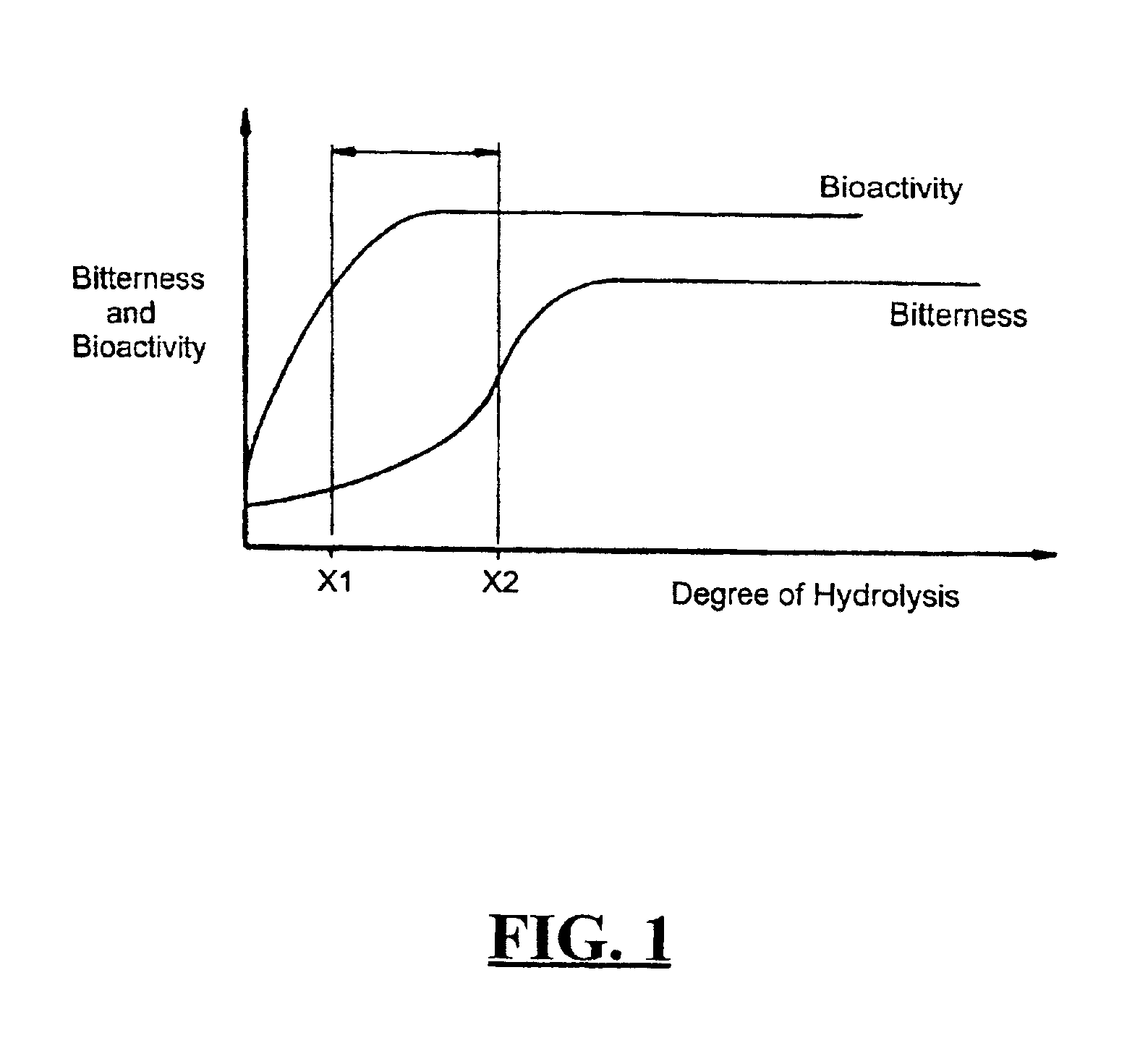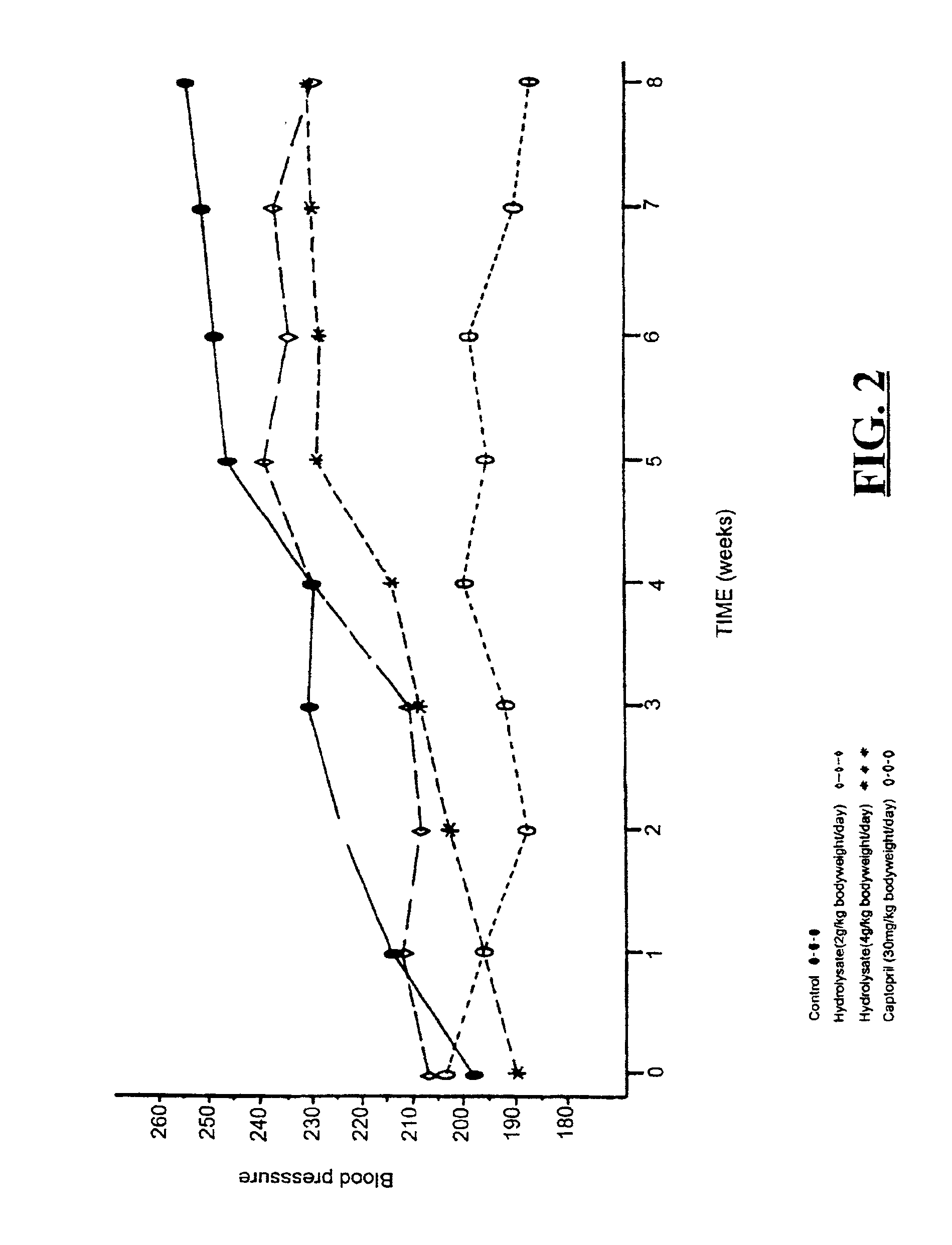Bioactive whey protein hydrolysate
a technology of whey protein and hydrolysate, which is applied in the field of bioactive whey protein hydrolysate, can solve the problems of reducing the chain length of all peptides, generating bitterness, and affecting the taste of whey protein, and achieves the effect of adding to the bioactive properties of the hydrolysa
- Summary
- Abstract
- Description
- Claims
- Application Information
AI Technical Summary
Benefits of technology
Problems solved by technology
Method used
Image
Examples
example 1
[0069]A 10% solution of a sweet whey protein concentrate with 80% protein content (ALACEN™ 392, 2 L) was hydrolysed at 50° C. with the commercially available enzyme Neutrase sourced from Bacillus subtilis (Novo Nordisk, Denmark). A pH of 7.0 and an enzyme substrate ratio of 0.3% w / w was used for the hydrolysis. The hydrolysate was adjusted to pH 5.0 and heated at 65° C. for 30 min to inactivate the enzyme. The hydrolysate (DH of 4.5%) was spray dried and tested for angiotensin-converting enzyme inhibitor (ACE-I) activity and flavour. ACE-I activity in the dried product was determined using FAPGG as a substrate (Product 305-10 ex Sigma Chemical Corporation, St Louis, Mo., USA) according of the method of D W Cushman & H S Cheung (1971). ACE-I activities are expressed as the amount of material (g / L) needed to reduce the activity of the ACE-I enzyme by 50%. IC50 ACE-I activity in the hydrolysate was 0.44 g / L and flavour acceptability score, as determined by a taste panel, was very high....
example 2
[0070]A 50% solution of ALACEN™ 421 whey protein concentrate (56% protein content, 10 L) was treated with commercial lactase sourced from Kluveromyces lactis (Lactozyme 3000 L ex Novo Nordisk) at an enzyme to substrate ratio of 0.3% at 50° C. for 2 hours. The lactase treated solution was hydrolysed with Neutrase (Novo Nordisk, Denmark) for 1 hour at 50° C. at an enzyme substrate ratio of 0.3%. Active enzymes were inactivated by UHT treatment (5 sec at 95° C.) after a five fold dilution of the mixture. The hydrolysate was spray dried. The dry powder (DH 2.8%) contained no traces of active enzyme and had an ACE-I activity of 2.18 g / L. The flavour score was exceptionally high due to the introduction of a low level of sweetening into the product. ACE-I measurements and flavour acceptability scoring were determined as for Example 1.
example 3
[0071]A 500 L hydrolase, made from ALACEN™ 392 in a similar way to that in example 1, was cooled to 10° C. after enzyme activation. A sub-sample of the original hydrolysate was dried. The remaining hydrolysate was subjected to ultrafiltration at 10° C. with a 10,000 dalton nominal molecular weight cutoff membrane (HFK 131, Koch Membrane Systems, USA). The hydrolysate (at a DH between 3.8% and 4.2%) was concentrated to a VCF 10 and the retentate was dried directly. The permeate was concentrated by evaporation to approx 25% solids and dried ACE-I measurement and flavour acceptability scoring were determined as for Example 1. The ACE-I activity was enriched in the permeate powder (IC50 of the permeate powder was 0.15 g / L). ACE-I activity in the sub-sample of the dried hydrolysate before ultrafiltration was 0.43 g / L. The flavour acceptability scores on the retentate powder and the spray dried powder of the feed were both high.
PUM
| Property | Measurement | Unit |
|---|---|---|
| temperature | aaaaa | aaaaa |
| temperature | aaaaa | aaaaa |
| temperature | aaaaa | aaaaa |
Abstract
Description
Claims
Application Information
 Login to View More
Login to View More - R&D
- Intellectual Property
- Life Sciences
- Materials
- Tech Scout
- Unparalleled Data Quality
- Higher Quality Content
- 60% Fewer Hallucinations
Browse by: Latest US Patents, China's latest patents, Technical Efficacy Thesaurus, Application Domain, Technology Topic, Popular Technical Reports.
© 2025 PatSnap. All rights reserved.Legal|Privacy policy|Modern Slavery Act Transparency Statement|Sitemap|About US| Contact US: help@patsnap.com



